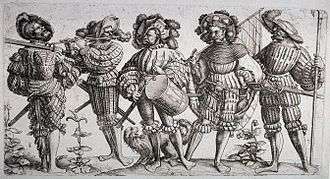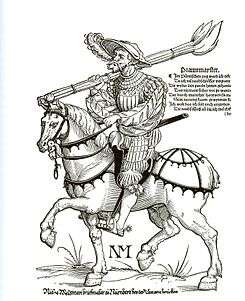Landsknecht

The German Landsknechts, sometimes also rendered as Landsknechte (singular Landsknecht, pronounced [ˈlantsknɛçt]) were colourful mercenary soldiers with a formidable reputation who became an important military force through late 15th- and 16th-century Europe. Consisting predominantly of German mercenary pikemen and supporting foot soldiers, they achieved the reputation for being the universal mercenaries of early modern Europe.[1][2]
Etymology
The Germanic compound Landsknecht (earlier Lantknecht, without fugen-s) combines land "land, country", here in the sense of "lowlands" and knecht "servant, vassal", here in the sense of "foot-soldier". The compound Lantknecht was used during the 15th century of bailiffs or court ushers. In its application to mercenaries, it is first recorded in the 1480s, perhaps coined by Peter von Hagenbach and intended to indicate soldiers of the lowlands of Swabia as opposed to the "highlander" Swiss mercenaries.
As early as 1500, the term was re-etymologized as Lanzknecht, suggesting a derivation from Lanze "lance; pike". The modern term Landser is possibly based on Landsknecht, as is the name of the French card game Lansquenet.
The more common English-language plural form is Landsknechts, but the original German form Landsknechte is also in use. Since it is a common noun, it may also be written with lower-case "l", landsknechts.
History


Maximilian I, Holy Roman Emperor from 1493 to 1519, formed the first mercenary Landsknecht regiments in 1487. He called upon Georg von Frundsberg (1473–1528), sometimes referred to as the Father of the Landsknechts, to assist him in their organization. Landsknechts later went on to fight in almost every 16th-century military campaign, sometimes on both sides of the engagement.
The Landsknechts, formed in conscious imitation of the Swiss mercenaries (and, initially, using Swiss instructors), eventually contributed to the defeat of the redoubtable Swiss, whose battle formations – over-dependent on hand-to-hand fighting – became vulnerable to the increased firepower of arquebus and artillery. French artillery or Spanish firepower dealt serious blows to the Swiss formations, and the Landsknecht pike blocks were there to fight off the depleted Swiss attack columns once this had occurred.
The Landsknechts were conservative in their usage of weapons and contained a large majority of pikemen. However, they inclined more to the tactical use of firearms than the Swiss because Landsknechts relied less on the precipitous rush to close combat. As Imperial soldiers, they often fought in formations mixed with Spaniards during the reign of King of Spain and Holy Roman Emperor Charles V. These Spaniards made a good widespread use of the arquebus and later, of the musket.
Landsknechte typically came from Swabia, Alsace, Tyrol and the Rhineland.
In the 1490s, the well-trained Landsknechte managed to defeat significantly greater Frisian armies.[3] Paul Dolstein wrote of the siege of Älfsborg in July 1502, fighting for the King of Denmark: "We were 1800 Germans, and we were attacked by 15000 Swedish farmers ... we struck most of them dead".[4] In 1521, the Spaniards recruited German infantrymen to defend their country against the French because, as they stated "our infantry does not perform as well in its native country as abroad." At the Battle of Bicocca and the Battle of Marignano (1515), they performed exceptionally well, notably crushing the famed Swiss Pikemen.
The Imperial Landsknechts were instrumental in many of the Emperor's victories, including the decisive Battle of Pavia in 1525. The same year, they also managed to defeat the peasants' revolt in the Empire. At their peak in the early 16th century, the Landsknechte were considered as formidable soldiers who were often brave and loyal. However, these qualities may have declined afterward.[5]
Indeed, from the 1560s on, the reputation of the Landsknechte steadily decreased. In the French Wars of Religion and the Eighty Years War, their bravery and discipline came under criticism, and the Spanish elements of the army of Flanders regularly deprecated the battlefield usefulness of the Landsknechts, somewhat unfairly. Their status also suffered from the rising reputation of the dreaded Spanish tercios which, however, were far less abundant and more expensive to train. It should also be noted that when serving in southern Europe, Landsknechte were still considered as elite troops.[6] In the army of the Dutch rebels, many German mercenaries were hired but were forced to give up many Landsknechte's traditions in order to increase their discipline and their fighting abilities.
They are attested as deployed in the armies of Kings John III of Navarre and successor Henry II of Navarre during their campaigns to reconquest Navarre (1512-1524). In the same context, they are found fighting on Charles V's side too (battle for Hondarribia, 1521-1524) where they performed strongly. They also served in high numbers in the Imperial army during the campaigns of Austria (1532), France (1542), Germany (1547) and in all the Italian wars.
The army of the Holy Roman Emperor defeated the French army in Italy, but funds were not available to pay the soldiers. The 34,000 Imperial troops mutinied and forced their commander, Charles III, Duke of Bourbon, to lead them towards Rome. The Sack of Rome in 1527 was executed by some 6,000 Spaniards under the Duke, 14,000 Landsknechts under Georg von Frundsberg, some Italian infantry and some cavalry.
Organization

The regiments often expanded from 4,000 to 10,000 men according to circumstances, or even larger, e.g. the 12,000 Landknechts raised by Frundsberg in 1526 for his campaign in Italy. It was this flexibility which allowed them to be used in various battle conditions. Oberste (colonels) were given recruiting commissions by the Emperor to form regiments, with a lieutenant-colonel and various regimental staff, and units divided into Fähnleins (companies) with a Hauptmann (captain) in charge, as well as lieutenants and Fähnriche (ensigns). Other ranks included majors of the court-martial and officers in charge of camp followers.
The Tross were the camp followers or "baggage train" who traveled with each Landsknecht unit, carrying the military necessities, the food and the belongings of each soldier and his family. The Tross was made up of women, children and some craftsmen.
Weapons
Landsknechts were trained in the use of the famous long pikes and used the pike square formations developed by the Swiss. The majority of Landsknechts would use pikes, but others, meant to provide tactical assistance to the pikemen, accordingly used different weapons. For example, an experienced Landsknecht could be designated a Doppelsöldner, an armoured soldier who served as the backbone for the formation and in addition to the pike as more recent recruits, they could also be alternatively employed wielding a 6-to-8-foot-long (1.8 to 2.4 m) halberd or partisan, or, more famously, a Zweihänder (literally: "Two-hander"), a two-handed sword as long as 180 cm (6 ft).[7] These great war swords could be used to knock the pikes aside, creating disorder among the tightly-arranged enemy pikemen in order to break through their lines. Other Doppelsöldner were armed with an early matchlock firearm called an arquebus or crossbow would lay ranged fire support by the flanks of the pike square.[8]

However, the primary use of the two-handed sword would be to serve as the guard for the standard bearer, as it is a weapon that allows for a few to oppose many.[7] The Swiss adversaries to the Landsknechts had specifically prohibited the use of these swords during the late 15th century, as they deemed them unsuitable for the constricted manner of pike warfare, though they continued to use the shorter longswords into and throughout the 16th century. "Doppelsöldner" meant "double pay man", because they were paid double the wages of their less-experienced counterparts. Landsknechts also used Kriegsmesser longswords (German for War knife) a long curved sword clasped to the belt, the blade shown naked without a scabbard in some woodcuts from 1500–1520.

Other Landsknechts would use the arquebus, the precursor to the musket. When the Landsknechts were first formed, arquebusiers composed up to an eighth of the total number of soldiers, but the number gradually grew to be about a quarter.
The universal Landsknecht weapon was a short sword called a Katzbalger, carried in addition to the Landsknecht's main weapon. Indeed, the Katzbalger was seen as the very symbol of the Landsknecht, Swiss illustrators being careful to depict it to indicate that a mercenary was a Landsknecht rather than a Reisläufer.

Clothes
What made the Landsknechts so conspicuous was their elaborate dress, which they adopted from the Swiss, but later took to even more dramatic excess. Maximilian I exempted them from the prevalent sumptuary laws as an acknowledgement of their "...short and brutish" lives.[9] Doublets (German: Wams), deliberately slashed at the front, back and sleeves with shirts and other wear pulled through to form puffs of different-colored fabric, so-called puffed and slashed; particoloured hose (or Gesses); jerkins (German: Lederwams); ever-broader flat beret-type hats (German: Tellerbarrets) with tall feathers; and broad flat shoes, made them bodies of men that could not be mistaken.
Camp
Landsknechts adopted the Hussite tactic of creating a ring of limbers and wagons, surrounded by cannon, with the encampment in the middle. While in strong positions like this, many Landsknechts lived in tents; however, in more makeshift situations, they would often build crude huts made of straw and mud supported by Pikes and Halberds. Commissioned officers would always sleep in tents on campaign. Quarrels and disease would go about the camp, and if the Landsknechts had been defeated in the battle the camp followers had little time to escape before rape and plunder took place. However, it was usually secure from the enemy.
See also
References
- ↑ The Landsknechts, Author: Douglas Miller, Publisher: Osprey Publishing, Great Britain, 1976, ISBN 0850452589.
- ↑ Landsknecht Soldier 1486-1560, Author: John Richards, Publisher Osprey Publishing, Great Britain, 2002, ISBN 1841762431.
- ↑ European warfare, 1350-1750, Tallett and Trim
- ↑ John Richards: Landsknecht Soldier, p. 51
- ↑ Mercenaries : a guide to private armies and private military companies, Alan Axelrod
- ↑ Parker, 2004: p.26.
- 1 2 "The Two-Handed Great Sword". Thearma.org. Retrieved 2016-11-17.
- ↑ Rogers, Cliff (2010). The Oxford Encyclopedia of Medieval Warfare and Military Technology , Volume 1. Oxford University Press. ISBN 0195334035.
- ↑ Rachel Ward – Introduction page – Saint Maximilian Landsknecht Reenactment Guild: "The Landsknechte were exempt from the sumptuary laws regulating clothing styles that other citizens had to follow. Maximilian granted them this dispensation because their lives tended to be so 'short and brutish.'"
Please add new comments below this notice. Thanks, ~~~~
External links
| Wikimedia Commons has media related to Landsknecht. |
- Landsknecht.org, International Landsknecht enthusiast society
- Saint Maximilian Landsknecht Reenactment Guild, Northern California
- Landsknecht clothing